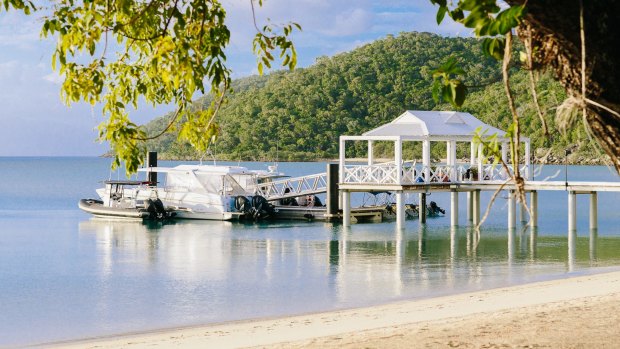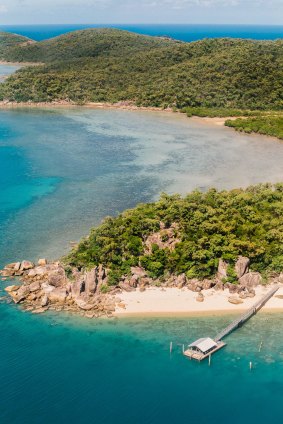This was published 6 years ago
Orpheus Island, Great Barrier Reef: An Australian paradise
By Peter Barrett
So, there we were. Forty kilometres from the nearest land, floating over a remote section of the outer Great Barrier Reef. Just me, my young family, and a two-metre shark. A whitetip reef shark, to be exact. But after nearly a week staying on Orpheus Island, I felt a strange sense of calm. Had I become acclimatised to these underwater predators, who prowled underneath the resort marina at night, fed like pets by the staff? Or was my guard simply down, lulled by several days of award-winning food, lazing around the pool and an unlimited, self-replenishing mini bar, included in the price of accommodation?
The answer is, probably both. Orpheus has a dual effect on guests. It's deeply relaxing, thanks to five-star facilities and personalised service that somehow manages to be laidback and yet slickly professional at the same time. But also, its location, 80 kilometres northeast of Townsville and surrounded by pristine reefs and protected oceans, means you can't help but encounter nature's raw beauty during your stay.
In fact, the nature spotting begins on approach, with an exciting helicopter transfer that zooms you from Townsville across Rattlesnake Island (used by the military for bombing practise), past nearby Fantome Island (a leper colony until 1973) and over coastlines dotted with aquamarine reefs, sea turtles and dugong.

Orpheus Island.Credit: Emma Byrnes
Named after an Australian Navy ship that sank in 1863 (which, in turn, was named after the legendary Greek poet, prophet and musician known for his ability to charm), Orpheus Island has been attracting tourists since the 1930s.
Jen Truasheim, the resort's gardener, longest resident and shoe-eschewing unofficial historian, says the place has changed a lot since she arrived to "chaos and madness" in 2000. "We had jet skis, we had ski boats, we had 90 guests, we had 50 staff; we had dead turtles out there being carved up by props." The ethos has done a U-turn for the better since the resort's two subsequent owners took over. The latest, Chris Morris (who made his fortune running global share registry Computershare and now has a string of pubs, restaurants, casinos and resorts under the Colonial Leisure Group banner) has worked hard to restore the balance of nature by investing heavily in eco-friendly infrastructure. Since he took over in 2011 the resort boasts a sewage treatment plant, solar hot water and guests are capped at 28. It's now more in keeping with the ethos of the rest of the island, which is predominantly national park. Happily for us, Morris is a grandfather, so unlike many similar exclusive tropical resorts, children are welcome here.
From the moment our helicopter touches down at the far end of the resort's beach the emphasis is on understated luxury. Our bags attended to (each guest is limited to 15kg), we take a short walk over the coconut palm-dotted lawn to the pool, where a glass of bubbly awaits. A solitary cockatoo screeches above, reminding us that this tropical paradise is very much Downunder. Sitting down with the resort manager, we learn of daily activities, such as snorkelling, fishing, kayaking and tours to nearby islands, that are included in the price of accommodation. Then it's time for the executive chef to grill us over our particular culinary likes, dislikes and inevitable quirks (for our fussy four-year-old that's easy: plain rice, noodles and Nutri-Grain, thanks). The food turns out to be a highlight of our stay, with a la carte breakfasts, ethnic themed share plates for lunch (Thai, American, Moroccan) and impressive degustation-style dinners that might include ricotta gnocchi with smoked clams and Moreton Bay Bug with black garlic aioli.

Orpheus Island.Credit: Emma Byrnes
After touring our modern suite (where fruits, a cheese platter and another bottle of sparkling wine are waiting for us) I venture past the horizon pool to the beach. Almost immediately I spot something unusual in the water. A couple of fins disturb the surface very close to the shore and, peering gingerly into the water lapping at my feet, I see a baby shark, about 50 centimetres in length cruising obliviously past. Later, the staff, who are well-versed on local flora and fauna, explain that it's a juvenile blacktip reef shark and, if I'd care to wait until dark, I could see plenty more larger specimens underneath the resort jetty. True to their word, that evening we watch transfixed as a staff member drops morsels of fish scraps into the water. Beneath us are about seven sharks, up to two metres long, circling and pouncing on the free dinner provided.
The next day we take out one of several tinnies available to guests and try our luck fishing. Hooking up to a buoy that marks the island's giant clam garden we snare a couple of undersized red emperors and throw them back. On the way home we spot a sea turtle and another cruising shark.
Then it's time to go on a larger adventure. We book a tour to nearby Hinchinbrook Island, the largest island national park in the world and about an hour away by boat. (These day tours cost extra, starting at $1200.) Gardener Jen is our guide and, as she recounts stories about local indigenous tribes on the boat crossing I become distracted by a three-metre-long hammerhead shark, the first I've ever seen in the wild, lazily swimming off the starboard bow. It's absolutely thrilling.
Then, past the foreboding sheer rock walls and boiling sea of Hinchinbrook's Hillock point, we enter the calmer waters of Zoe Bay, eventually stepping out onto the estuary's small beach. Jen, a botanist by training, enthusiastically identifies the rainforest trees and plants around us: spiky 'lawyer' palms (whose thorns were used by indigenous people for sewing needles), red beech (good for boat-building timber) and quandong trees that bear edible purple-blue fruits. We walk for 20 minutes to Zoe Falls, where Jen pulls out a couple of pesky march flies we'd dispatched earlier and drops them into the clear, fresh, mountain stream-fed pool. Almost before they hit the water there is a threshing bubble and splash and they are snapped up by a school of beautiful gold and black-spotted jungle perch. We spend the rest of the day lazing on the rocks and swimming in the cool, crystal clear water, marvelling at the fish.
But no journey to this part of the world would be complete without a close inspection of the Great Barrier Reef. After learning about the perils of crown of thorns starfish and plastic rubbish during a visit to Orpheus Island's marine research station (a remote campus of James Cook University nestled in an adjoining bay to the resort) we take to the boat again and head nearly 40 kilometres northeast to the isolated Walker Reef. Surrounded by ocean and entirely lost in one of the seven wonders of the natural world, it's now that I spot that beautiful, two-metre whitetip shark cruising beneath us. But, instead of fear, I notice the animal evokes another instinct in me: protection.
TRIP NOTES
MORE
traveller.com.au/orpheus-islandorpheus.com.au
VISIT
The 11-kilometre-long, 1-kilometre-wide island is a national park about 80 kilometres northeast of Townsville. Jellyfish season is November to March, although the resort provides stinger suits as a precaution. Trade winds blow from April to August so the best time to visit is around September to October when nights are still relatively cool. (That said, we visited in mid-December and had a pleasant, sunny, jellyfish-free stay with daily temperatures in the early 30s.)
FLY
Qantas, Virgin, and Jetstar all fly to Townsville and Cairns. From there, a helicopter takes you to the island (guests limited to no more than 15kg luggage each). The chopper from Townsville costs $295 per person, one-way for the 25-minute trip; from Cairns it costs $725 per person, one-way for the 90-minute flight. See qantas.com, virginaustralia.com and jetstar.com and orpheus.com.au.
STAY
The resort is limited to 28 guests who stay in villa-studio style accommodation. Wine, beer, soft drinks and food is included in the accommodation price, which starts at $1500 per night for a couple. Other drinks, such as cocktails or cellared wines cost extra. It is also possible to stay at the James Cook University Orpheus Island Research Station as a working volunteer. For more information and to apply, see jcu.edu.au/orpheus-island. The Queensland Government operates three campsites on the island. To book permits see npsr.qld.gov.au.
Peter Barrett and family received discounted accommodation at the resort and paid for their own flights and transfers.
See also: Australia top 20 best holiday islands
See also: Australia's best beaches for 2018 named
Sign up for the Traveller Deals newsletter
Get exclusive travel deals delivered straight to your inbox. Sign up now.